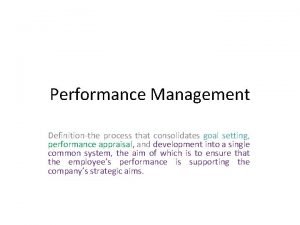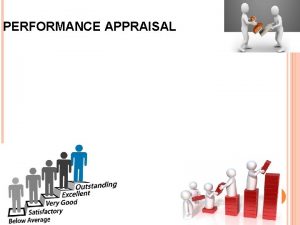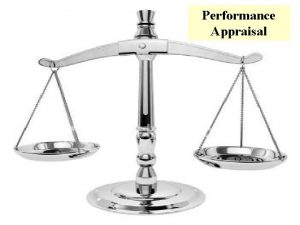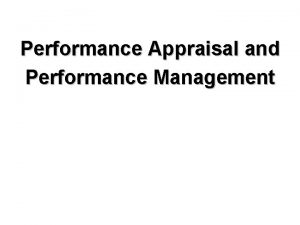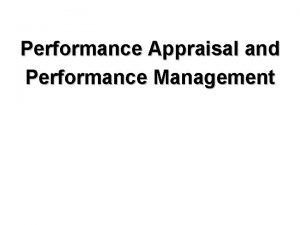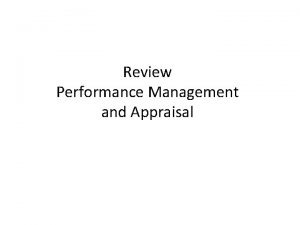Performance Management Appraisal Part I The purposes and










- Slides: 10

Performance Management & Appraisal, Part I • The purposes and requirements of an effective performance management and appraisal system • Legal and strategic issues in performance appraisal • Appraisal formats: Advantages and disadvantages

Performance Management & Appraisal • Performance management – Defines performance – Facilitates Performance – Encourages performance • Performance Appraisal – Measures performance – Evaluates performance – Feeds back the evaluation

Legal & Strategic Issues • Legal issues – Performance appraisal is open to adverse impact – Criteria must be applied equally • Strategic issues – Organizations get what they reward – Need to align strategy with performance management system

Using Performance Appraisal • Developmental – Improving performance – Career development • Administrative – Salary decisions – Promotion – Retention

Relative & Absolute Judgments • Relative – Ranking – Forced distribution • Absolute – Graphic rating scales – Behavioral checklists – Critical incidents

Scale Formats Graphic Rating Scale Quality of Work 1 Poor 2 Below Average Graphic Rating Scale clearer anchors 3 Average 4 5 Good Excellent Quality of Work 1 2 Frequent Passable Errors 3 Usually accurate 4 Errors rare 5 Accurate

Trait and Behavioral Data • Traits – Personality – Individual traits • Behavioral data – BARS (create dimensions, write critical incidents, rate critical incidents, form scales with incidents as anchors – BOS

Scale Formats Behaviorally Anchored Rating Scale For Supervision 5: Can train and develop subordinates 4: Exhibits respect towards subordinates 3: Critical of personnel in front of others 2: Sets a poor example 1: Reneges on promises

Outcome Data • Meeting goals • Quantitative data – sales – scrappage – productivity

Backwards & Forwards • Summing up: We began with distinguishing performance management from performance appraisal. Legal and strategic issues were considered and the balance of the session reviewed different rating formats, their advantages and disadvantages. • Looking ahead Next time we complete our discussion of performance management by looking at challenges to effective performance management, the appraisal interview, motivation, and performance improvement.
 Purposes of performance appraisal
Purposes of performance appraisal Performance management vs performance appraisal
Performance management vs performance appraisal Performance management vs performance appraisal
Performance management vs performance appraisal Potential appraisal
Potential appraisal Performance management and appraisal chapter 8
Performance management and appraisal chapter 8 Performance management and appraisal chapter 8
Performance management and appraisal chapter 8 Management by objectives performance appraisal
Management by objectives performance appraisal Mbo performance appraisal method
Mbo performance appraisal method Management fifteenth edition
Management fifteenth edition Performance management appraisal program
Performance management appraisal program Absolute performance standard
Absolute performance standard










